Lincoln Center
Lincoln Center for the Performing Arts (also simply known as Lincoln Center) is a 16.3-acre (6.6-hectare) complex of buildings in the Lincoln Square neighborhood of Manhattan in New York City.[1] It has thirty indoor and outdoor facilities and is host to 5 million visitors annually.[1] It houses nationally and internationally renowned performing arts organizations including the New York Philharmonic, the Metropolitan Opera, and the New York City Ballet. Juilliard School of Music also became part of the Lincoln Center complex.
.jpg) The David H. Koch Theater (left), The Metropolitan Opera House (center), and David Geffen Hall (right) and the Revson Fountain in front | |
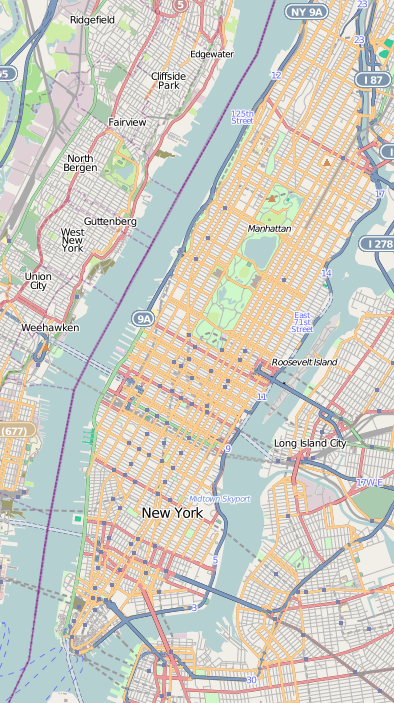 Lincoln Center Location within Manhattan  Lincoln Center Lincoln Center (New York City)  Lincoln Center Lincoln Center (New York) | |
| Location | 10 Lincoln Center Plaza New York, NY 10023 |
|---|---|
| Coordinates | 40.7720°N 73.9847°W |
| Public transit | New York City Subway: |
| Type | Performing-arts center |
| Construction | |
| Built | 1955–1969 |
| Opened | 1962 (when the center's first venue, Philharmonic Hall, opened) |
| Website | |
| lincolncenter | |
History
Planning
.jpg)
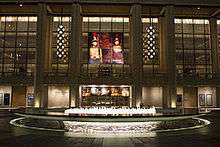
A consortium of civic leaders and others led by, and under the initiative of, John D. Rockefeller III built Lincoln Center as part of the "Lincoln Square Renewal Project" during Robert Moses' program of urban renewal in the 1950s and 1960s.[2] Respected architects were contracted to design the major buildings on the site, and over the next thirty years the previously diverse working class area around Lincoln Center was replaced with a conglomeration of high culture to please the tastes of the consortium.[3]
Rockefeller was appointed as the Lincoln Center's inaugural president in 1956, and once he resigned, became its chairman in 1961.[4] He is credited with raising more than half of the $184.5 million in private funds needed to build the complex, including drawing from his own funds; the Rockefeller Brothers Fund also contributed to the project.[2] Numerous architects were hired to build different parts of the center (see § Architects). The center's first three buildings, David Geffen Hall (formerly Avery Fisher Hall, originally named Philharmonic Hall), David H. Koch Theater (formerly the New York State Theater) and the Metropolitan Opera House were opened in 1962, 1964 and 1966, respectively.[4]
It is unclear whether the center was named as a tribute to U.S. President Abraham Lincoln or for its location in the Lincoln Square Neighborhood. The name was bestowed on the area in 1906 by the New York City Board of Aldermen, but records give no reason for choosing that name.[5] There has long been speculation that the name came from a local landowner, because the square was previously named Lincoln Square. However, property records from the New York Municipal Archives from that time have no record of a Lincoln surname; they only list the names Johannes van Bruch, Thomas Hall, Stephan de Lancey, James de Lancey, James de Lancey, Jr. and John Somerindyck.[6] One speculation is that references to President Lincoln were omitted from the records because the mayor in 1906 was George B. McClellan Jr., son of General George B. McClellan, who was general-in-chief of the Union Army early in the American Civil War and a bitter rival of Lincoln's.[7]
Historical timeline
- April 21, 1955: The Mayor's Slum Clearance Committee chaired by Robert Moses is approved by the New York City Board of Estimate to designate Lincoln Square for urban renewal.[8]
- November 8, 1955: John D. Rockefeller III is elected as chairman.[8]
- June 22, 1956: Lincoln Center for the Performing Arts, Inc. incorporated.[8]
- October 31, 1956: Lincoln Square Development Plan is approved, many changes to the area are proposed.[9]
- May 14, 1959: Ground-breaking ceremony with U.S. President Dwight D. Eisenhower.[8]
- April 6, 1964: Lincoln Center Fountain, named for Charles Revson, opens.[4]
- April 23, 1964: New York State Theater opens.[4]
- October 14, 1965: Vivian Beaumont Theater and the Forum (now Mitzi E. Newhouse Theater) open.[4]
- November 30, 1965: The Library & Museum of the Performing Arts opens.[4]
- August 1, 1966: The first indoor festival in the United States, the Midsummer Serenades - A Mozart Festival begins.[4]
- September 16, 1966: The Metropolitan Opera House opens.[4]
- May 22, 1969: Damrosch Park and the Guggenheim Band Shell opens.[4]
- September 11, 1969: Alice Tully Hall (named for Alice Tully) opens.[4]
- October 26, 1969: Juilliard School opens.[4]
- May 20, 1974: The Lincoln Center Institute is officially founded.[10]
- October 22, 1974: The Avery Fisher Artist Program is founded to give outstanding American instrumentalists significant recognition on which to continue to build their careers. It includes both The Avery Fisher Prize and the Avery Fisher Career Grants.[10]
- January 30, 1976: The first live telecast of Live from Lincoln Center is broadcast over PBS.[10]
- October 19, 1976: Avery Fisher Hall re-opens after renovation to improve acoustics.[10]
- December 4, 1981: The Big Apple Circus marks its first performances at its winter home in Damrosch Park. The circus has performed every winter at Lincoln Center through the 2016 season when it was forced to liquidate its assets due to continued financial losses.[11]
- September 7, 1982: New York State Theater re-opens after renovation to improve acoustics.[12]
- August 3, 1987: Classical Jazz, Lincoln Center's first concert series devoted exclusively to jazz, begins in Alice Tully Hall.[12]
- November 19, 1990: The Samuel B. and David Rose Building opens housing the Walter Reade Theater, the Stanley H. Kaplan Penthouse, the Daniel and Joanna S. Rose Rehearsal Studio, the Clark Studio Theater, the School of American Ballet, Juilliard School student residences, and office space for a number of the member organizations.[13]
- January 27, 1991: The Mozart Bicentennial at Lincoln Center opens with concerts held at Avery Fisher Hall and the Metropolitan Opera House, making it the world's largest and most comprehensive tribute to the life and works of Mozart.[13]
- June 13, 1994: Beverly Sills is elected Chairman of the Board of the Lincoln Center for the Performing Arts, Inc. She is the first woman and the first professional musician to be elected to this position, serving until May 1, 2002.[13]
- January 18, 2001: The Lincoln Center Constituent Development Project is established to implement and oversee the comprehensive reconstruction, renovation, and modernization of Lincoln Center for the Performing Arts.[14]
- October 18, 2004: Jazz at Lincoln Center opens. The hall is made up of three theaters: the Rose Theater, the Allen Room, and Dizzy's Club Coca-Cola.[14]
- March 20, 2006: Preliminary construction on the West 65th Street Project begins. The Promenade Project, a plan to renovate Josie Robertson Plaza and the Columbus Avenue frontage to the Lincoln Center campus, is announced.[14]
- June 8, 2006: Lincoln Center announces plans to transform the nearby Harmony Atrium into a public space for the arts open to the public, neighbors, students, and center patrons.[14]
- February 22, 2009: Alice Tully Hall reopens after redevelopment.[15]
- September 30, 2009: Opening of the redesigned Charles H. Revson Fountain.[14]
- October, 2009: A turfgrass roof is installed at Lincoln's Center North Plaza as a part of the organization's initiative to go green.[16]
- May 21, 2010: Renovation plans of central and north plazas unveiled.[17]
- June 4, 2012: Claire Tow Theater opens.[14]
- October 1, 2012: The President's Bridge opens over West 65th Street.[18]
- May 15, 2013: Jed Bernstein begins tenure as president.[19]
- October 1, 2013: The New York City Opera files for Chapter 11 bankruptcy reorganization and ceases operation.[20]
- October 9, 2014: Thirty-six solar panels are installed on the roof of Lincoln Center's Rose Building to continue the green initiative. .[14]
- September 24, 2015: Avery Fisher Hall renamed David Geffen Hall.[21]
- January 22, 2016: The New York City Opera resumes performances in the Rose Theater.[22]
- November 16, 2016: Debora Spar becomes Lincoln Center's first woman president after the sudden departure of Jed Bernstein.[23][24]
- September 3, 2019: Allison Allen was hired as chief people officer, a newly created position to lead human resources functions with a core focus on implementation of LCPA's diversity, equity, and inclusion (DEI) plan.[25]
Construction milestones
In 1955, the first city institution to commit to be part of the Lincoln Square Renewal Project, an effort to revitalize the city's west side with a new performing arts complex that would become the Lincoln Center for the Performing Arts, was the Fordham Law School of Fordham University.[26] In 1961, Fordham Law School was the first building to open as part of the renewal project, and in 1968, Fordham College at Lincoln Center welcomed its first students.[26]
The development of the condominium at 3 Lincoln Center,[27] completed in 1991, designed by Lee Jablin of Harman Jablin Architects, made possible the expansion of The Juilliard School and the School of American Ballet.[27][28][29]
The center's cultural institutions also have since made use of facilities located away from the main campus. In 2004, the center expanded through the addition of Jazz at Lincoln Center's newly built facilities, the Frederick P. Rose Hall, at the new Time Warner Center, located a few blocks to the south.[14] In March 2006, the center launched construction on a major redevelopment plan that modernized, renovated, and opened up its campus. Redevelopment was completed in 2012 with the completion of the President's Bridge over West 65th Street.[18]
Renovations
When first announced in 1999, Lincoln Center's campuswide redevelopment was to cost $1.5 billion over 10 years and radically transform the campus.[30] The center management held an architectural competition, won by the British architect Norman Foster in 2005, but did not approve a full scale redesign until 2012, in part because of the need to raise $300 million in construction costs and the New York Philharmonic's fear that it might lose audiences and revenue while it was displaced.[31][32] Among the architects that have been involved were Frank Gehry; Cooper, Robertson & Partners; Skidmore, Owings & Merrill; Beyer Blinder Belle; Fox & Fowle; Olin Partnership; and Diller & Scofidio.[33]
In March 2006, the center launched the 65th Street Project – part of a major redevelopment plan continuing through the fall of 2012 – to create a new pedestrian promenade designed to improve accessibility and the aesthetics of that area of the campus. Additionally, Alice Tully Hall was modernized and reopened to critical and popular acclaim in 2009 and the Film Society of Lincoln Center expanded with the new Elinor Bunin Munroe Film Center. Topped by a sloping lawn roof, the film center is part of a new pavilion that also houses a destination restaurant named Lincoln, as well as offices. Subsequent projects were added which addressed improvements to the main plazas and Columbus Avenue Grand Stairs. Under the direction of the Lincoln Center Development Project, Diller Scofidio + Renfro in association with FXFOWLE Architects and Beyer Blinder Belle Architects provided the design services. Additionally, Turner Construction Company and RCDolner, LLC[34] were the construction managers for the projects.[35][36] Another component to redevelopment was the addition of the David Rubenstein Atrium designed by Tod Williams Billie Tsien Architects, a visitors' center and a gateway to the center that offers free performances, day-of-discount tickets, food, and free Wi-Fi.
| Buildings of Lincoln Center |
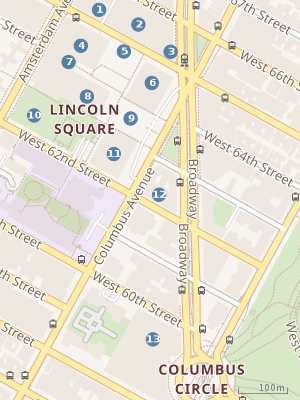 |
Buildings and structures in Lincoln Center: 1 2 3 4 5 6 7 8 9 10 11 12 13 |
Architects
Architects who designed buildings at the center include:
- Diller Scofidio + Renfro:[37] Public spaces,[38] Hypar Pavilion and Lincoln Ristorante, The Juilliard School, Alice Tully Hall,[39] School of American Ballet,[40] Josie Robertson Plaza,[41] Revson Fountain,[42] President's Bridge (over 65th Street)[43] and Infoscape
- Max Abramovitz: David Geffen Hall, original design of Josie Robertson Plaza (with Wallace K. Harrison and Philip Johnson)[41]
- Pietro Belluschi: The Juilliard School (including Alice Tully Hall). Modified by Diller Scofidio + Renfro in association with FXFOWLE Architects[39]
- Gordon Bunshaft: The New York Public Library for the Performing Arts.[4]
- Wallace Harrison: the center's master plan, the Metropolitan Opera House, and original design of Josie Robertson Plaza (with Max Abramovitz and Philip Johnson)[41]
- Lee S Jablin: 3 Lincoln Center, the adjacent condominium built by a private developer[44]
- Philip Johnson: New York State Theater, now known as the David H. Koch Theater, original design of Josie Robertson Plaza (with Wallace K. Harrison and Max Abramovitz)[41] and original Revson Fountain[42]
- Eero Saarinen: Vivian Beaumont Theater[4]
- Davis, Brody and Associates: The Samuel B. and David Rose Building.[13]
- Billie Tsien, Tod William: The David Rubenstein Atrium[37][44]
- Hugh Hardy/H3 Hardy Collaboration Architecture LLC: The Claire Tow Theater[40]
- WET Design: Revson Fountain[42]
- Nina Rappaport and Ken Smith[45]
Constituent structures
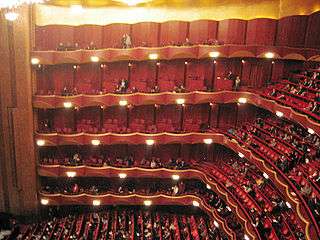
.jpg)
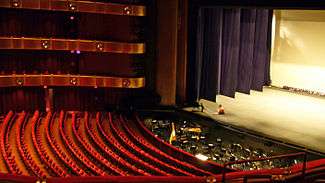
The center has 30 indoor and outdoor performance facilities including:
- Metropolitan Opera House: a 3,900-seat opera house; the home stage of the Metropolitan Opera; as well as List Hall
- David Geffen Hall (formerly Philharmonic Hall and Avery Fisher Hall): a 2,738-seat symphony hall; the home stage of the New York Philharmonic
- David H. Koch Theater (formerly New York State Theater): a 2,586-seat theater; constructed as the home of the New York City Ballet, it is also the former home of the New York City Opera and the Music Theater of Lincoln Center companies
- Alice Tully Hall: a 1,095-seat concert hall located within the Juilliard School building; the home stage of The Chamber Music Society of Lincoln Center
- Vivian Beaumont Theater: a 1,080-seat Broadway theater; operated since 1985 as the main stage of Lincoln Center Theater; previously occupied by The Repertory Theater of Lincoln Center (1965–1973) and The New York Shakespeare Festival (1973–1977)
- Mitzi E. Newhouse Theater (originally known as the Forum): a 299-seat theater; operated by Lincoln Center Theater for its Off-Broadway-style productions[46]
- The Walter Reade Theater: a 268-seat movie theater; used by the Film Society of Lincoln Center; features a raised dais used for post-screening filmmaker discussions
- Claire Tow Theater: a 131-seat theater operated by Lincoln Center Theater to house more experimental productions
- Elinor Bunin Munroe Film Center[47]: home to the Francesca Beale Theater, Howard Gilman Theater, and the Amphitheater
- Bruno Walter Auditorium[48] at the New York Public Library for the Performing Arts
- The David Rubenstein Atrium: a facility on Broadway between 62nd and 63rd Streets; includes a public visitors' and discount-ticketing facility with amenities that include free performances and a café
- The Clark Studio Theater: a 120-seat dance theater; a part of the facilities of Lincoln Center Education[49]
- Damrosch Park: an outdoor amphitheater with a bowl-style stage known as the Guggenheim Band Shell; used for free Lincoln Center Out of Doors presentations and with a special dance floor for Midsummer Night Swing.
- Daniel and Joanna S. Rose Rehearsal Studio
- Josie Robertson Plaza: the center's central plaza, featuring its iconic fountain; the three main buildings (Metropolitan Opera House, David Geffen Hall, and David H. Koch Theater) face onto this plaza; used as an outdoor venue during Lincoln Center Out of Doors presentations
- Juilliard School: a facility housing the school of the same name: building also incorporates Morse Recital Hall, Paul Recital Hall, the Juilliard Drama Theater and the Peter Jay Sharp Theater
- Stanley H. Kaplan Penthouse[50]: a nightclub-style venue; used for intimate concerts, "Meet the Artist" and Great Performers events, lectures, and other events where a small, intimate space is preferred; was also used for jazz performances prior to the construction of the new Jazz at Lincoln Center facilities
- Jazz at Lincoln Center: while a part of the center, it is located separately in the Frederick P. Rose Hall complex within the Time Warner Center at Columbus Circle. It consists of the following performance and related facilities:
- The Appel Room: a 508-seat amphitheater with 50-foot (15-metre) glass wall overlooking Central Park and Columbus circle; from 2011 to 2013, it was used as the studio for Anderson Live, a daytime-television talk show hosted by Anderson Cooper
- Dizzy's Club Coca-Cola: a nightclub-style venue that allows jazz to be performed in its traditional venue
- Rose Theater: a 1,094-seat concert hall designed for jazz performances. Rose Theater is the largest performing space in the Lincoln center. It consists of three floors. The first floor is orchestra, the second floor is Mezzanine, and the third floor is balcony.
- Irene Diamond Education Center: a rehearsal, recording and classroom facility
- Other outdoor venues include Hearst Plaza, Barclay's Capital Grove, and Broadway Plaza.[51]
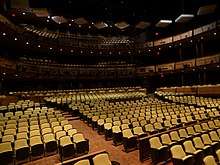
Resident organizations
The center serves as home for twelve resident arts organizations:[52]
- The Chamber Music Society of Lincoln Center
- Film Society of Lincoln Center (sponsor of the New York Film Festival)
- Jazz at Lincoln Center
- Juilliard School
- Lincoln Center for the Performing Arts
- Lincoln Center Theater
- Metropolitan Opera
- New York City Ballet
- New York City Opera
- New York Philharmonic
- New York Public Library for the Performing Arts
- School of American Ballet
- Lincoln Center Education
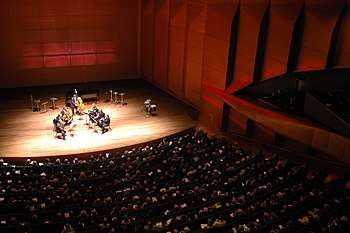
The Chamber Music Society of Lincoln Center
The Chamber Music Society of Lincoln Center is, along with New York Philharmonic, New York City Ballet, Lincoln Center Theater, and the Metropolitan Opera, one of the eleven constituents of the Lincoln Center for the Performing Arts. Alice Tully Hall is the venue for the CMS activities (performances, education programs, recording sessions, broadcast activities…) since it opened in 1969.[54][55]
There is a large variety of concerts and events for all kind of audiences; CMS’s commitment is to try to program chamber music dating from the Renaissance to our 21th Century. All this becomes true thanks to the magnificent roster of performing artists, composed by the world’s finest chamber musicians and, of course, to the leadership of both Co-artistic Directors David Finckel (cellist of Emerson String Quartet) and Wu Han (pianist).
In an attempt to achieve international recognition and reach, the CMS has different season projects outside the country and a nationally televised broadcast, international radio series, regular broadcasts on SiriusXM and the possibility to enjoy live streamed performances on the CMS website.[56]
Lincoln Center for the Performing Arts
Lincoln Center for the Performing Arts (LCPA) is one of the twelve resident organizations, and serves three primary roles: presenter of artistic programming, national leader in arts and education and community relations, and manager of the center's campus. As the world's largest presenter of performing arts offering some 5,000 programs, initiatives and events annually, its programs include American Songbook, Great Performers, Lincoln Center Festival, Lincoln Center Out of Doors, Midsummer Night Swing, the Mostly Mozart Festival, Target Free Thursdays, the White Light Festival and the Emmy Award–winning Live from Lincoln Center.[52][57]
In July 2006, the LCPA announced it would join with publishing company John Wiley & Sons to publish at least 15 books on performing arts, and would draw on the Lincoln Center Institute's educational background and archives.[58]
Jazz at Lincoln Center
In 1987, Classical Jazz had their first jazz concert series and jazz division was created with Wynton Marsalis. He was the artistic director of JALC and also the music director of the Lincoln Center Jazz Orchestra in 1996.[59] This ensemble performs classic jazz works as well as premiere new pieces. The orchestra performed many new compositions from composers such as Benny Carter, Benny Golson, Geri Allen, Marcus Roberts, Melba Liston, and John Lewis.[60] There are well known performances from famous jazz musicians like Duke Ellington, Count Basie, Fletcher Henderson, Thelonious Monk, Mary Lou Williams, Dizzy Gillespie, and Chales Mingus.[60]
The LCJO (Lincoln Center Jazz Orchestra) first toured in Europe of 1995, then to Russia, China, Taiwan, Japan and Australasia. In USA spring of 2000, there was a tour for a program of jazz and dance.[60]
Cultural Innovation Fund
Lincoln Center Cultural Innovation Fund is the first of its kind as a grant program that seeks to make the arts accessible to all people, focusing on those who live in some of New York City's poorest neighborhoods.[61] Partnering with the Rockefeller Foundation, the new pilot grant program offers one-time grants to non-profit organizations to provide cultural activities in these communities in the diverse neighborhoods of Central Brooklyn and the South Bronx.[62] Each of the 12 grantees will receive support and financial backing for their project based on organizational budget size. These are one-year long projects, and grant amounts range from $50,000-$100,000.[62] The over-all goal of the program is to support non-profit organizations in creating cultural innovative strategies that cultivate participation in the arts as well as increase the range and availability of cultural activities to underserved communities.[63]
Corporate Sponsors
- 200 Amsterdam
- American Express
- Bank of America
- BNY Mellon
- Colgate-Palmolive
- First Republic Bank
- Holland America
- J.C.C.I
- Mitsubishi Corporation(Americas)
- Mitsui & Co. (U.S.A.), Inc.
- Morgan Stanley
- Movado
- NBCUniversal
- NewYork-Presbyterian
- Nippon Steel & Sumitomo Metal U.S.A., Inc.
- Nordstrom
- Omnicom
- PepsiCo
- PGIM
- Sumitomo Corporation of America
- Zabar’s and Zabars.com
- The Walt Disney Company[64]
In popular culture
Lincoln Center is featured in multiple works of art and media. Examples include:
Films:
- A Thousand Clowns (1965), Shown while under construction
- No Way to Treat a Lady (1968), in which Kate Palmer (Lee Remick) works there as a tour guide
- The Producers (1968), in which the theatrical producers Max Bialystock (Zero Mostel) and Leo Bloom (Gene Wilder) meet at the Revson Fountain to discuss their scheme to defraud their investors; the climax of the scene is provided by the eruption of the plaza's fountain while Bloom dances around
- Ghostbusters (1984), Peter meets Dana by the fountain after her rehearsal with a guest conductor
- Pitch Perfect (2012), in which the final competition takes place at Lincoln Center
- John Wick: Chapter 2 (2017), in which a shootout takes place in the plaza before moving into the Subway
Television:
- The King of Queens: Main characters Doug (Kevin James) and Carrie Heffernan (Leah Remini) attend a cello concert in the Season 1 episode "Cello, Goodbye".
Video games:
- In Marvel's Spider-Man for the PlayStation 4, many Manhattan landmarks are recreated, including Lincoln Center.
- The building is recreated as a placeable landmark in the 2003 video game SimCity 4
See also
- Essentially Ellington High School Jazz Band Competition and Festival
- List of museums and cultural institutions in New York City
References
Notes
- "Lincoln Center". www.lincolncenter.org. Retrieved September 27, 2019.
- "Rockefeller Philanthropy: Lincoln Center" (PDF format).
- Roth, Leland M. (2001). American Architecture: A History. Boulder, Colo.: Westview Press. ISBN 9780813336619, ISBN 9780813336626. OCLC 47867623.
- "Archive 1960s | Lincoln Center for the Performing Arts". www.aboutlincolncenter.org. Retrieved September 27, 2019.
- Gray, Christopher (October 2, 2005). "Streetscapes: Readers' Questions; The Story of a Name, the Tale of a Co-op". The New York Times. Retrieved May 18, 2012.
- Collins, Glenn (May 11, 2009). "50 Years In, Lincoln Center's Name Is Still a Mystery". The New York Times. Retrieved September 27, 2019.
- Collins, Glenn (May 11, 2009). "50 Years In, Center's Name Is Still a Mystery". The New York Times. Retrieved November 15, 2010.
- "Archive 1950s | Lincoln Center for the Performing Arts". www.aboutlincolncenter.org. Retrieved September 27, 2019.
- "The Construction of Lincoln Center for the Performing Arts (1959-69) - Lincoln Center for the Performing Arts". Google Arts & Culture. Retrieved February 16, 2020.
- "Archive 1970s | Lincoln Center for the Performing Arts". www.aboutlincolncenter.org. Retrieved September 27, 2019.
- Davis, Janet M. (January 17, 2017). "Farewell Ringling Bros., but the circus isn't dead". CNN. Retrieved January 18, 2018.
- "Archive 1980s | Lincoln Center for the Performing Arts". www.aboutlincolncenter.org. Retrieved September 27, 2019.
- "Archive 1990s | Lincoln Center for the Performing Arts". www.aboutlincolncenter.org. Retrieved September 27, 2019.
- "Archive Today | Lincoln Center for the Performing Arts". www.aboutlincolncenter.org. Retrieved September 27, 2019.
- Sisario, Ben. (May 6, 2008) "Tully Hall to Reopen in 2009 With Eclectic Music Festival" The New York Times Retrieved May 23, 2014.
- McIntyre, Linda (2010). "Lincoln Center's Green Carpet". Landscape Architecture. 100 (11): 46–56. ISSN 0023-8031. JSTOR 44795565.
- Ouroussoff, Nicolai (May 20, 2010). "The Greening of Lincoln Center". The New York Times. Retrieved July 31, 2010.
- Pogrebin, Robin. (October 1, 2012) "New Bridge at Lincoln Center to Open Monday". The New York Times Retrieved May 23, 2014.
- Pogrebin, Robin. "Lincoln Center Turns to Broadway for Its Next Chief". The New York Times. Retrieved May 12, 2014.
- "New York City Opera To File For Bankruptcy". Billboard. Retrieved January 18, 2018.
- Smith Jennifer (September 24, 2015) "Lincoln Center Concert Hall Renamed for David Geffen". The Wall Street Journal Retrieved September 27, 2015.
- Stearns, David Patrick (January 25, 2016). "New York City Opera's resurrection may be right". Philadelphia Inquirer. Retrieved January 18, 2018.
- "Lincoln Center for the Performing Arts Appoints Debora L. Spar as President and CEO" (Press release). Lincoln Center. November 16, 2016. Retrieved August 7, 2017.
- Morgan, Richard (May 5, 2016). "The bosses who got screwed for boning in the corner office". New York Post. Retrieved August 7, 2017.
- "Press Release | Lincoln Center for the Performing Arts". www.aboutlincolncenter.org. Retrieved September 27, 2019.
- L, Ekins Dianna. "History". www.fordham.edu. Retrieved September 27, 2019.
- Goldberger, Paul (July 28, 1991). "Architecture View". The New York Times.
- Gill, Brendan (August 19, 1991). "The Skyline". The New Yorker. pp. 57–60.
- Bosco, Pearl (November 1989). "Three Lincoln Center". Institute for Urban Design. Project Monograph. Vol. 2, No. 4.
- Robin Pogrebin (May 8, 2003), "Lincoln Center Proceeds, Modestly". The New York Times.
- Pogrebin, Robin (November 28, 2012), "Avery Fisher Hall to Be Renovated". The New York Times.
- Polsky, Sarah. (November 29, 2012) "Avery Fisher Hall Will Finally Get Its Long-Delayed Makeover" Curbed NY
- Pogrebin, Robin. (June 19, 2003), "Costs and Approach Disputed in Lincoln Center Redevelopment". The New York Times.
- "RCDolner Construction". Rcdolner.com. May 11, 2012. Retrieved May 31, 2017.
- Pogrebin, Robin (August 17, 2006). "On 65th Street, Glimpsing Lincoln Center's Future". The New York Times. Retrieved July 31, 2010.
- "Transforming Lincoln Center" on Lincoln Center website Archived May 28, 2013, at the Wayback Machine
- "Transforming Lincoln Center: Architecture and Design". Lincoln Center. Retrieved January 2, 2018.
- "Lincoln Center: New Public Spaces and Amenities" (PDF). Lincoln Center. Retrieved January 2, 2018.
- "Lincoln Center: Alice Tully Hall Fact Sheet" (PDF). Lincoln Center. Retrieved January 2, 2018.
- "Lincoln Center: West 65th Street Project Fact Sheet" (PDF). Lincoln Center. Retrieved January 2, 2018.
- "Lincoln Center: Josie Robertson Plaza / Columbus Avenue" (PDF). Lincoln Center. Retrieved January 2, 2018.
- "Lincoln Center Revson Fountain Fact Sheet" (PDF). Lincoln Center. Retrieved January 2, 2018.
- "Lincoln Center: President's Bridge at Lincoln Center" (PDF). Lincoln Center. Retrieved January 2, 2018.
- "Lincoln Center: David Rubenstein Atrium at Lincoln Center Fact Sheet" (PDF). Lincoln Center. Retrieved January 2, 2018.
- Rappaport, Nina; Smith, Ken (2005). "Modern Landscape Architecture, a Forgotten Art: The Case of Lincoln Center". Future Anterior: Journal of Historic Preservation, History, Theory, and Criticism. 2 (1): 50–57. ISSN 1549-9715. JSTOR 25834961.
- See Mitzi E. Newhouse Theater at the Internet Off-Broadway Database for a list of productions in the venue.
- "Now Playing". Film at Lincoln Center. Retrieved February 15, 2020.
- www.nypl.org https://www.nypl.org/bruno-walter-auditorium. Retrieved February 15, 2020. Missing or empty
|title=(help) - Pogrebin, Robin. (October 8, 2013) "$4 Million Grant to Help Rebrand Lincoln Center Institute" The New York Times Retrieved May 23, 2014.
- "Lincoln Center". www.lincolncenter.org. Retrieved February 15, 2020.
- "Map of Lincoln Center" Archived July 2, 2014, at the Wayback Machine. Retrieved May 23, 2014.
- "What Is Lincoln Center, and What Is a Resident Organization?". Lincoln Center for the Performing Arts. Retrieved August 7, 2017.
- "Lincoln Center". www.lincolncenter.org. Retrieved February 21, 2020.
- "Lincoln Center". www.lincolncenter.org. Retrieved February 21, 2020.
- "Drew University". Drew University. Retrieved February 21, 2020.
- "History and Mission | The Chamber Music Society of Lincoln Center". www.chambermusicsociety.org. Retrieved February 21, 2020.
- "About Lincoln Center for the Performing Arts, Inc. (LCPA)". About Lincoln Center and Lincoln Center for the Performing Arts, Inc. (LCPA). Retrieved May 23, 2014.
- Maul, Kimberly (July 27, 2006). "Wiley and Lincoln Center Dance Together". The Book Standard.
- Suhadolnik, Sarah (January 13, 2015). "Jazz at Lincoln Center". Grove Music Online. Oxford University Press. doi:10.1093/gmo/9781561592630.article.a2275877.
- Kennedy,Gary W. "Lincoln Center Jazz Orchestra [LCJO]". Grove Music Online. doi:10.1093/gmo/9781561592630.article.J623500. Retrieved February 21, 2020.
- Center, Foundation. "Lincoln Center Cultural Innovation Fund Awards Innovation Fund Grants". Philanthropy News Digest (PND). Retrieved November 8, 2017.
- "Lincoln Center Cultural Innovation Fund". Lincoln Center Cultural Innovation Fund. Retrieved September 27, 2019.
- "Press Release | Lincoln Center for the Performing Arts". www.aboutlincolncenter.org. Retrieved November 8, 2017.
- "Corporate Sponsors | Lincoln Center for the Performing Arts". www.aboutlincolncenter.org. Retrieved February 16, 2020.
Bibliography
- Young, Edgar B. (1980). Lincoln Center: The Building of an Institution. New York: New York University Press. ISBN 9780814796566. OCLC 6446862.
External links
| Wikimedia Commons has media related to Lincoln Center for the Performing Arts. |
- lincolncenter.org, the center's official website
- Lincoln Center with Patti LuPone—Documentary produced by Treasures of New York
- Lincoln Center for the Performing Arts at Google Cultural Institute